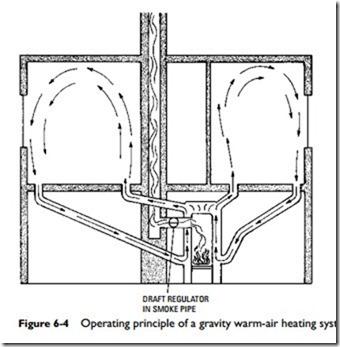Gravity Warm-Air Heating Systems
A gravity warm-air heating system (Figure 6-4) consists of a properly designed furnace (with casing and smoke pipe), a warm-air supply delivery system, and a cool-air return system.
In a central heating system, the warm air is delivered to the rooms and spaces being heated through a system of air ducts, the exception being a gravity floor furnace or a pipeless furnace. Those ducts located in the basement and extending (or leading) from the furnace to the basement ceiling are referred to as leaders. The stacks are warm-air ducts or pipes that connect to the leaders and extend vertically within the walls and up through the building. The warm air enters a room through registers located on the walls or floor (the former will generally connect to a stack, the latter to a leader). The cooler room air exits a room by means of return grilles and travels back through return air ducts to the furnace where it is reheated and recirculated.
A gravity warm-air heating system differs from the forced- warm-air type by relying primarily on gravity to effect air circulation. The operating principle of the gravity warm-air heating system is based on the fact that the weight per unit volume of air decreases as its temperature increases and increases as its temperature decreases. As the air is heated in the furnace, it expands and becomes lighter. Because it is lighter, it is displaced by the cooler, heavier air entering the furnace. The warmer, lighter air moves through the leaders and up through the wall stacks, where it enters the rooms through the registers. As the air cools, it becomes heavier and returns through the return air grilles and ducts to the furnace—hence the name gravity warm-air heating systems.
Air circulation in a gravity warm-air heating system depends upon the difference in temperature between the rising warm air and the cooler air that is falling and returning to the furnace for reheating. The greater the difference in temperature, the faster the move- ment of the air; however, natural conditions will place upper limits on the speed of the air movement, making it advisable to equip a gravity-type central furnace with a fan as an integral part of its con- struction. Such an integral fan should be powerful enough to over- come internal duct resistance to air flow and is absolutely necessary if air filters are used in the heating system. The motive force of air circulation in a standard gravity system is not strong enough to overcome the resistance of filters.
Planning a Gravity Warm-Air Heating System
Several trade and professional associations provide information for planning a gravity warm-air heating system. A very useful source of information is the Gravity Code and Manual for the Design and Installation of Gravity Warm Air Heating Systems (Manual 5) from the former National Warm-Air Heating and Air Conditioning Association. You should also check relevant publications from its successor association, the Air-Conditioning Contractors of America (ACCA).
The following recommendations for planning such a system are offered as a basic planning guide:
1. Calculate the heat loss from each room in the structure, and add these together for the total heat loss.
2. Plan the leaders (i.e., the horizontal ducts or pipes leading from the furnace) so that none are longer than 10 ft in length.
3. Keep the number of elbows in the leader to a minimum.
4. Locate the warm-air outlets (registers) and return air grilles as close to the floor in each room as possible.
5. Locate the warm-air outlets (registers) on the inside walls of each room and in that part of the room closest to the furnace.
6. Select warm-air and return air ducts according to their Btu carrying capacities.
7. Select a furnace capable of delivering in Btu/h a register delivery equal to the total heat loss calculated for the structure.
8. Locate the furnace in the lowest part of the structure and as near to the center as possible.
